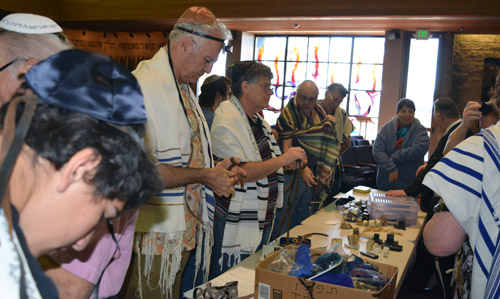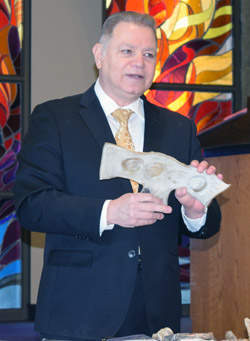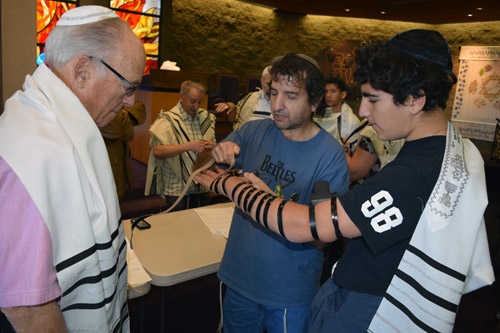
By Donald H. Harrison


SAN DIEGO — Across the United States and in Conservative congregations around the world, Men’s Club members and guests spent Sunday morning, Feb. 7, well in advance of the televised Super Bowl game, learning about the significance of tefillin and the prayers said in association with wearing the ancient phylacteries. The international event is called World Wide Wrap Day.
Sofer Alberto Attia of San Diego, participating in one such event at Tifereth Israel Synagogue, noted that four passages from the Torah are placed inside separate compartments inside the head piece of the tefillin, while the same four passages are written on a single scroll for concealment in the arm piece.
Each of the passages instructs the Jewish people to write down God’s words and to bind them as a sign upon their hand and as an ornament between their eyes. The four passages are: Exodus 13: 1-10; Exodus 13:11-16; Deuteronomy 6: 4-9; and Deuteronomy 11: 13-21. As translated from Hebrew in the Art Scroll Tanach, they are reprinted at the end of this article.
Attia said one may find within the passages references to the past, present and future relationship between God and the Jewish Nation, signifying that their betrothal is eternal. At the same time, he said, when the passages are transmitted from one generation to the next, they teach the Jewish people’s collective memory that by God’s strong hand, the Jews were led out of the slavery of Egypt. In return, Jews undertake certain obligations to God, including the observance of the week of Passover, and the redeeming of first-born sons (today, through a donation to charity.)
Historically, the ink used to write the Scripture on the parchment was drawn from oak trees, which grew all over the Middle East. When wasps disturbed the oak trees, the trees exuded nut-like galls. Before wasp eggs could hatch within them, the galls were crushed, producing tannic acid, according to Attia. The acid then was mixed with gum Arabic and with soot from burned twigs, producing a paste. To this was added the juice of pomegranates and honey, and once the mixture was dried “it was able to last for many hundreds of years.”
“Today,” Attia added, “we have different formulas, but it is interesting how things were done at that time.”
The housing for the tefillin passages is made from a single piece of leather, which must be carefully worked by hand in a year-long process, Attia taught.
He held up a piece of leather that he said, “came from the neck of a cow, the only place where the hide is so thick that we can make tefillin of this type.”
The sofer said that “out of one cow we usually can get two tefillins; one for the head and one for the hand. Sometimes if it is a much larger animal, we can get two for the hand and one for the head.”
We could see that the leather had been pressed with four equal-sized circles — described by Attia as the three-month point in the year-long process. The leather had to be “treated in a solution of lime water to pickle it because anything made out of hide or leather or meat, if not treated that way, will rot,” he said. “Once it is cured, then it is able to last hundreds of years. We have found tefillin all the way back to Masada in the Judean Desert, 2000 years old, and we can still see the housings intact. It is amazing how leather can be preserved over time.”
The stiff leather with the four circles “is soaked in water overnight and … just like a dry sponge that is hard and stiff, the tefillin will absorb the water, and will become soft and malleable like jelly.” The circles are worked by hand until they are shaped into separate compartments capable of holding the parchment. Meanwhile “the top parts have been molded to become square.” In olden times, a thinner leather was used and a crank was utilized to apply pressure to the leather to make it square. However, “we have square metal inserts. We hammer them in and then we apply pressure. We have dividers so they (the compartments) will not squish each other. Today, we use about 5,000 pounds of pressure to mold tefillin of this type.”
Forming the housing of the tefillin into a perfect square is ritually mandatory. If the tefillin varies from a square by “more than the thickness of a finger nail, the tefillin are no good,” said Attia. ”They have to be that exact.”
Squares have symbolic significance, Attia taught. They are man-made shapes, as they cannot be found occurring in nature. They symbolize man’s quest to perfect the world, in partnership with God. Squares have four sides, and “many things that are associated with tefillin have the number four associated with them. We have four compartments, four parchments,” and painted onto one side of the housing is a four-headed shin (a Hebrew letter that usually has only three heads). “Besides that we have a knot in the back. For some, we have the custom of making a square knot, that is of four sides. Another custom is to make a knot in the shape of (the Hebrew letter) dalet, which is the fourth letter of the aleph-bet.”
The four-headed shin stands for the four matriarchs: Sarah, Rebecca, Rachel and Leah, while a three-headed shin painted on the opposite side of the housing represents the patriarchs: Abraham, Isaac and Jacob.
The square symbolizes the military configuration of the camps that Moses and the Jews made as they wandered for 40 years through the wilderness. The sanctuary (Beit HaMikdash) was in the middle, and the tribes of Israelites arrayed themselves in formations facing the four sides of the tent.
Attia said the leather working involved in making tefillin recalls the Jewish people’s experience as a pastoral people who herded sheep and cattle before their incarceration as slaves in Egypt,
Another reminder are wisps of cow’s tail that wrap the four parchments. In Jewish tradition, said Attia, when people stray from God they are said to have gone to the “other” side. In this case, the wisp of the tail makes us remember that even as God was saving the Jews, some were straying as in the episode with the Golden Calf.
In wrapping the tefillin on one’s arm, there is more symbolism: The straps cross the hand in such a way as to form the letters shin, dalet, and yud– the Hebrew spelling of one of God’s names, Shadai, meaning The Protector.
Attia said that tefillin, with all its symbolism, help to recall the history and belief systems of the Jewish people.
“It is a hidden world unless we want to reconnect and investigate a little bit,” he said. Otherwise, it “remains aloof and we are not able to make contact with the richness of our tradition.”

*
THE TORAH PASSAGES WITHIN THE TEFILLIN
Exodus 13: 1-10 HaShem spoke to Moses, saying, “Sanctify to Me every firstborn, the first issue of every womb among the Children of Israel, of man and beast, is mine. Moses said to the people, “Remember this day on which you departed from Egypt, from the house of bondage, for with a strong hand God removed you from here, and therefore chametz may not be eaten. Today you are leaving, in the month of springtime. And it shall come to pass when HaShem shall bring you to the land of the Canaanite, the Hittite, the Emorite, the Hivvite, and the Jebbusite, which He swore to your forefathers to give you – a land flowing with milk and honey—you shall perform this service in this month. For a seven-day period shall you eat matzos, and on the seventh day there shall be a festival to Hashem. Matzos shall be eaten throughout the seven-day period; no chametz may be seen in your possession, nor may leaven be seen in your possession in all your borders. And you shall tell your son on that day saying, “It is because of this that HaShem acted on my behalf when I left Egypt. And it shall be for you a sign on your arm and a reminder between your eyes—so that Hashem’s Torah may be in your mouth – for with a strong hand Hashem removed you from Egypt. You shall observe this decree at its designated time from year to year.
Exodus 13: 11-16: “It shall come to pass, when Hashem will bring you to the land of the Canaanites, as He swore to you and your forefathers, and He will have given it to you; then you shall set apart every first issue of the womb to HaShem, and of every first issue that is dropped by livestock that belong to you; the males are HaShem’s. Every first issue donkey, you shall redeem with a lamb or kid; if you do not redeem it, you shall axe the back of its neck. And you shall redeem every human firstborn among your sons. And it shall be when your son will ask you at some future time, ‘What is this?’ you shall say to him, ‘With a strong hand HaShem removed us from Egypt from the house of bondage. And it happened when Pharaoh stubbornly refused to send us out, that HaShem killed all the firstborn of the land of Egypt, from the firstborn of man to the firstborn of beast. Therefore I offer to HaShem all male first issue of the womb, and I shall redeem all the firstborn of my sons. And it shall be a sign upon your arm, and an ornament between your eyes, for with a strong hand Hashem removed us from Egypt.
Deuteronomy 6:4-9: Hear O Israel: HaShem is our God, HaShem is the One and Only. You shall love HaShem, your God, with all your heart, with all your soul and with all your resources. And these matters that I command you today shall be upon your heart. You shall teach them thoroughly to your children and you shall speak of them while you sit in your home, while you walk on the way, when you retire and when you arise. Bind them as a sign upon your arm and let them be ornaments between your eyes. And write them on the doorposts of your house and upon your gates.
Deuteronomy 11: 13-21: It will be that if you harken to My commandments that I command you today, to love HaShem, your God, and to serve Him with all your heart and with all your soul, then I shall provide rain for your Land in its proper time, the early and the late rains, that you may gather in your grain, your wine, and your oil. I shall provide grass in your field for your cattle and you will eat and you will be satisfied. Beware for yourselves, lest your heart be seduced and you turn astray and serve gods of others and prostrate yourselves to them. Then the wrath of HaShem will blaze against you; He will restrain the heaven so there will be no rain, and the ground will not yield its produce; and you will be swiftly banished from the goodly Land that HaShem gives you. You shall place these words of Mine upon your heart and upon your soul; you shall bind them for a sign upon your arm and let them be an ornament between your eyes. You shall teach them to your children to discuss them, while you sit in your home, while you walk on the way, when you retire and when you arise. And you shall write them on the doorposts of your house and upon your gates. In order to prolong your days and the days of your children upon the Land that HaShem has sworn to your forefathers to give them, like the days of the heavens over the earth.
*
Harrison is editor of San Diego Jewish World. He may be contacted via donald.harrison@sdjewishworld.com. Comments intended for publication in the space below must be accompanied by the letter writer’s first and last name and by his/ her city and state of residence (city and country for those outside the U.S.)
Pingback: World Wide Wrap and the making of tefillin | The Ruach